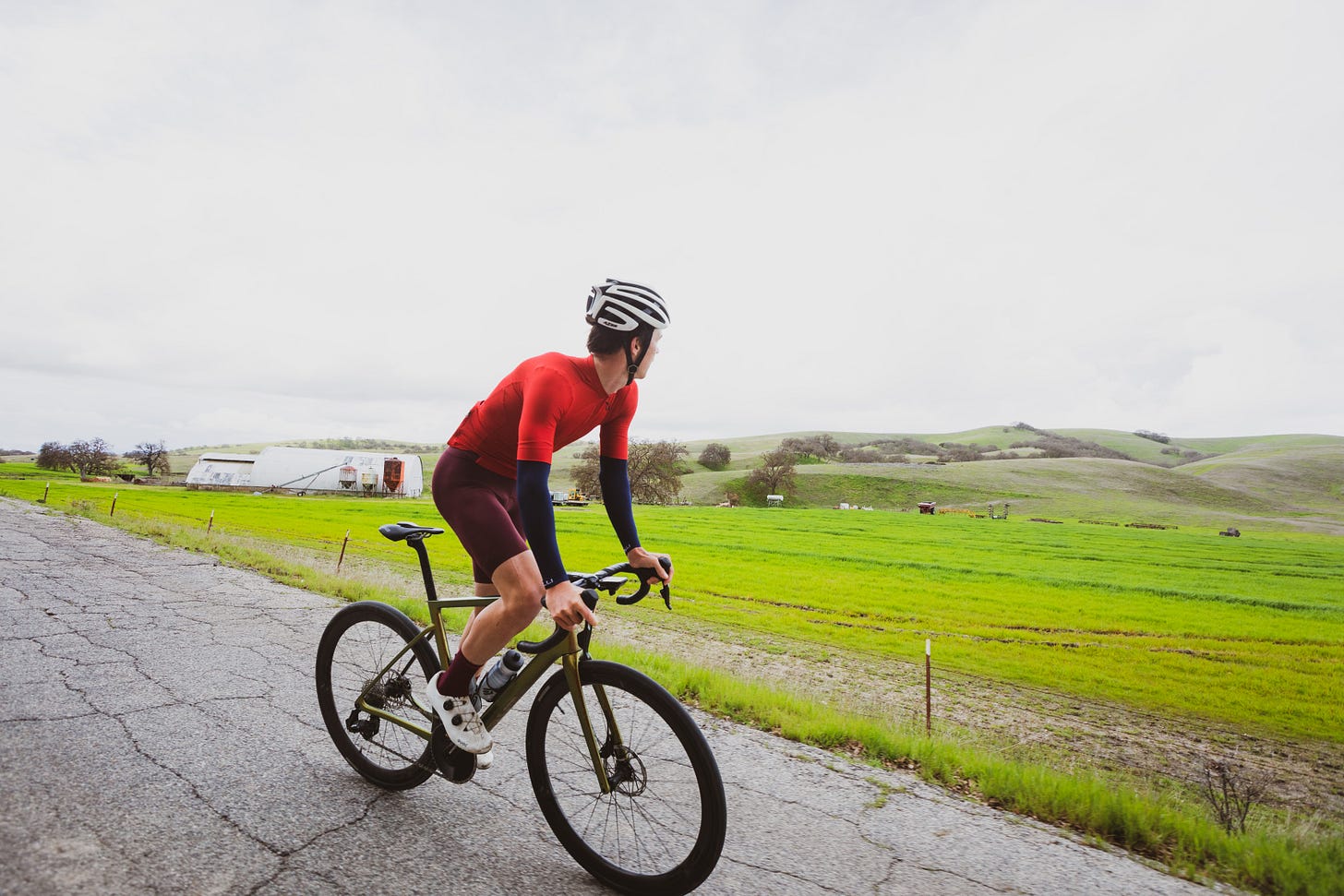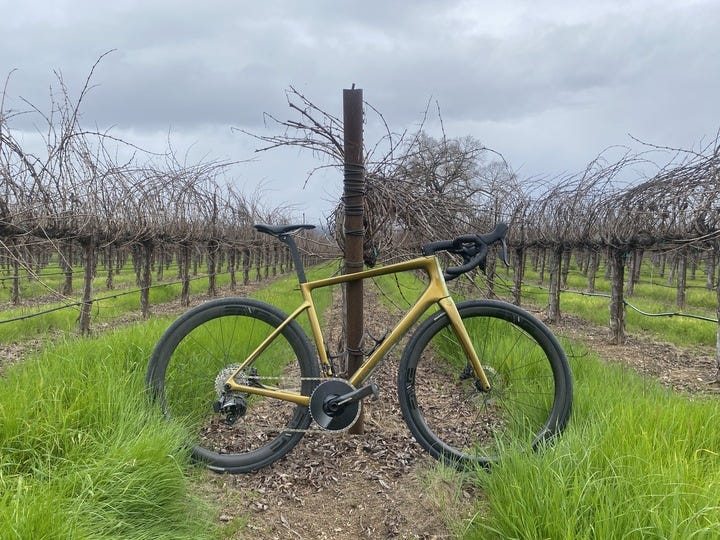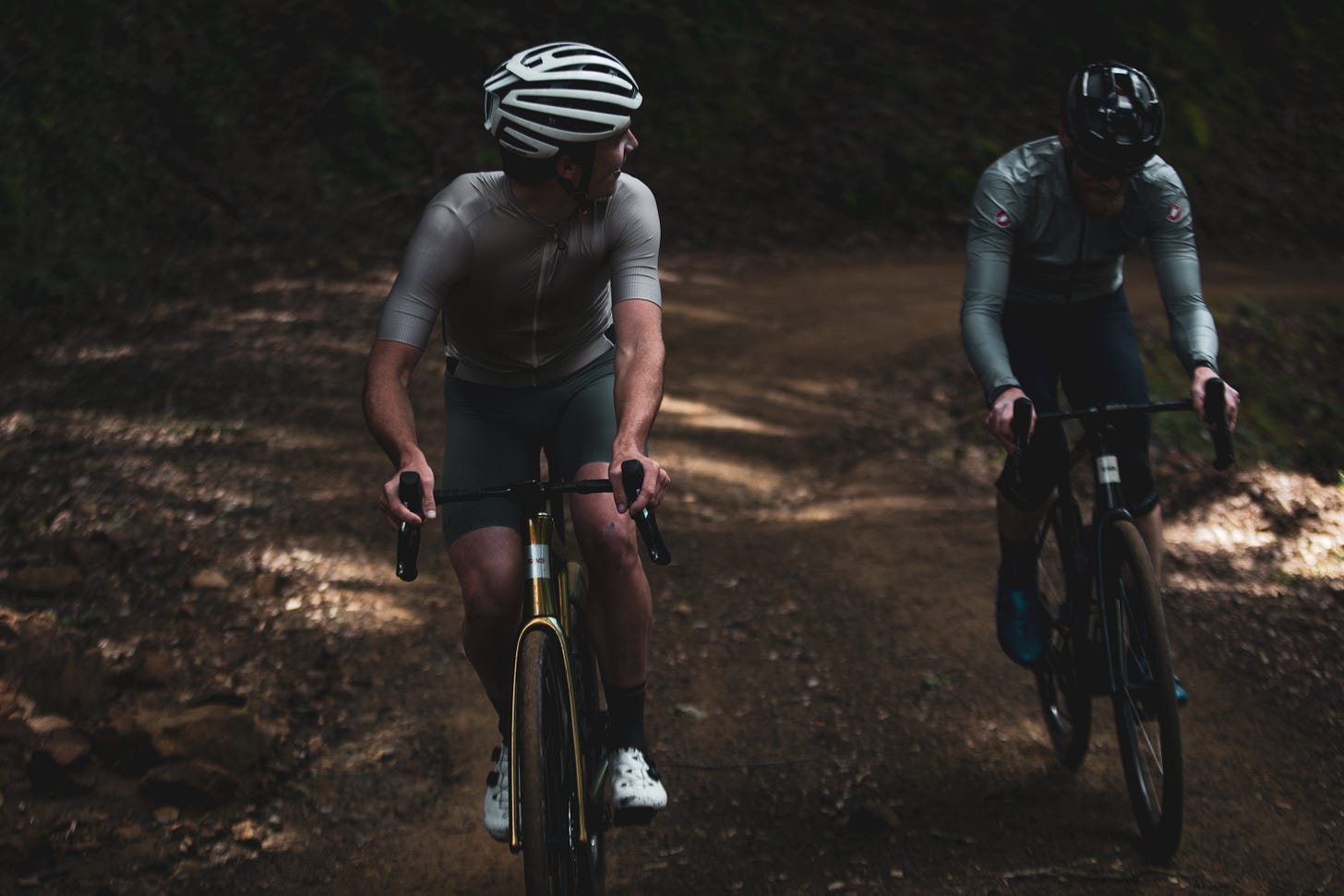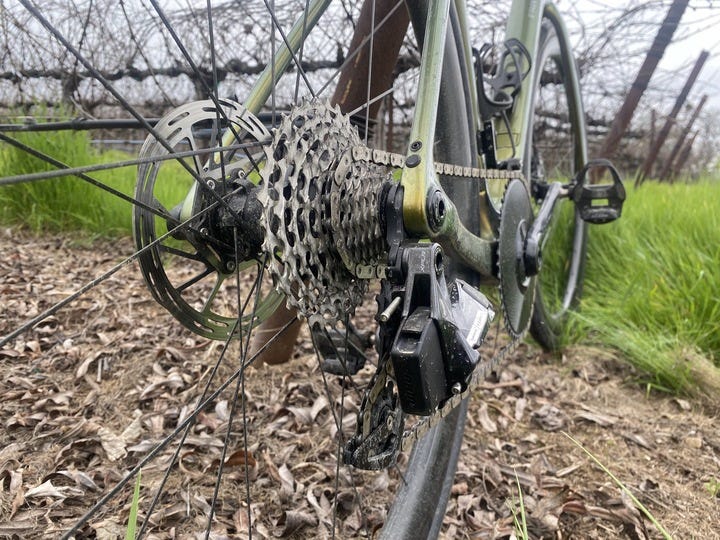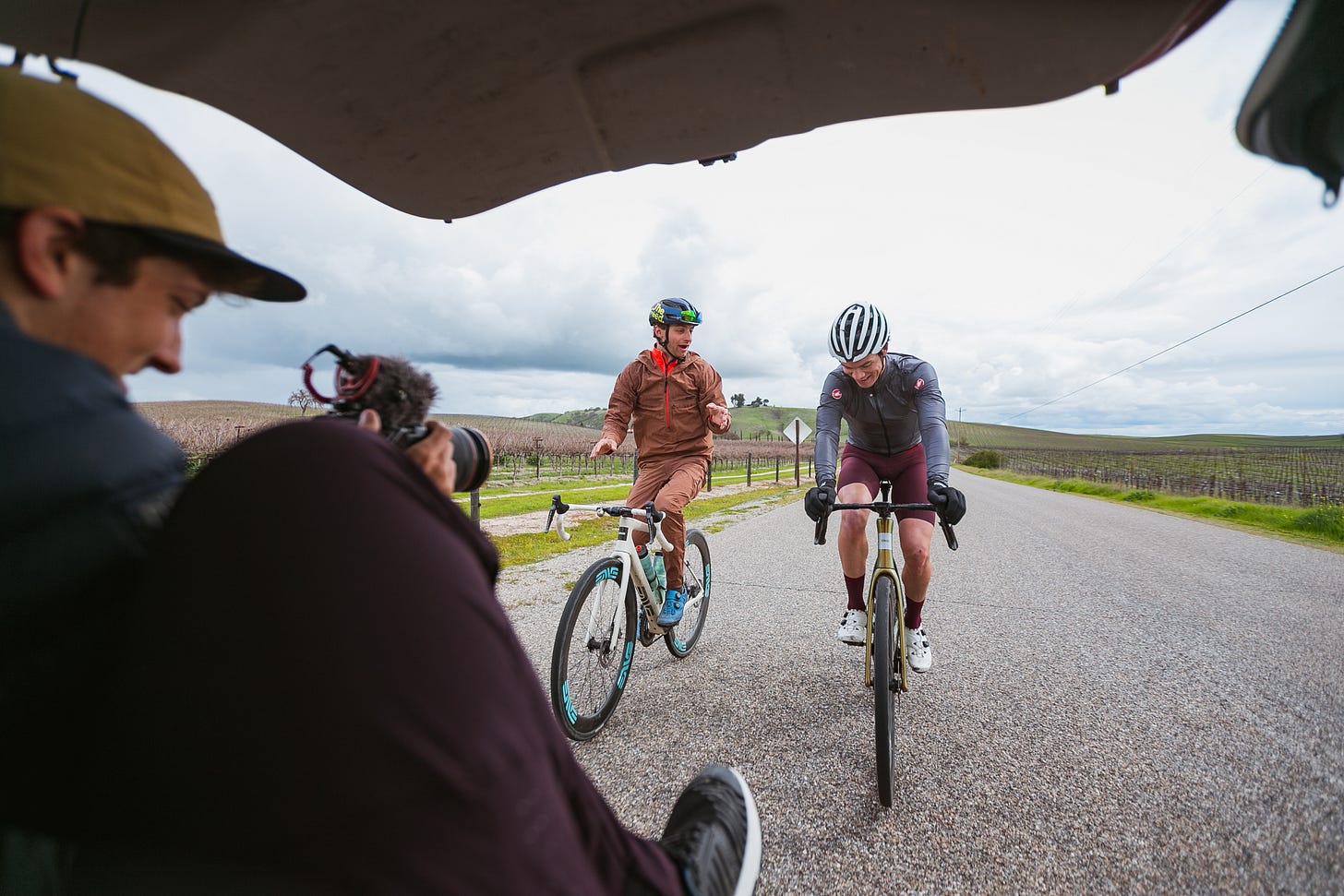Enter, the Fray
Enve’s new high-clearance road bike thrives in its specificity. But is that a good thing?
The last part of ‘A side of Cycling’ was not supposed to be reviews. The tech side of cycling was one where I rarely delved too deeply into. That was until this year when I began to think about bikes and the tech that drives them a bit more. With that increased curiosity came a desire to write down some of my thoughts about tech through the lens of being a experience and curious rider who falls just shy of being a tech nerd. Maybe with that voice my reviews will be a little different and relate to a different subset of people.
So that is what I am doing, starting off with a review of the Enve Fray all-road bike. Now, boutique bikes are not typically what I will be writing about. For one, I have a close relationship with Rodeo Adventure Labs and that will always create a certain conflict of interest in writing about any kind of gravel bike. But, perhaps more importantly, I think the frame itself is not what reviews should spend the most time with. I believe that more time should be dedicated to all the cheaper aspects of cycling tech that can have an even greater impact on someones rider.
Nevertheless, I think the Enve Fray presents a lot of bigger meta questions about the bike industry that I am super interested in. It’s a bike that will rub many the wrong way, but for some will be a kind of key that unlocks a new appreciation for cycling. It is for that reason why I made the discussion of this bike the tone setter for reviews to come. I hope you enjoy!
At first blush the new Enve Fray is thrilling. Standing still it looks fast, with a performance geometry and beautifully crafted geometry that blurs the line between the out-and-out performance road bikes and a race-oriented gravel bike.
Squint and you could confuse it with Enve’s other offering, the Melee. In fact, while I was testing the Fray for the first time I rode with an Enve rider who I thought was also riding the Fray. Turns out he was instead riding a Melee. I could spot the differences when I looked closer – a more sculpted shape to the down tube, a narrower gap around the rear tire and the slightly taller frame of the Fray – but it was not readily apparent that our builds were different.
Yet different they are. The Fray, unlike the Melee, is built around 35mm tires. Yes, the Fray has a clearance that runs up to 40mm with a 1x and of course the ability to drop the tire width down to 28 or less, but the engineers have stressed that it is built around mid-sized slicks. It is an endurance or all-road set-up, if you will, that has grown in popularity as disc road bikes have opened up that “tweener” tire size for riders and companies alike to toy with.
At its heart, the Fray is a bike that is built around a spec that is optimized for un-specific road riding, a big gamble from the brand, but a gamble that the engineers at Enve have been considering for a long time with this bike given a full extra year of development compared to the MOG and the Melee.
Why so specific?
Enve describes the Fray as a high-performance bike geared towards the everyday rider. With the Melee in their lineup, the Fray is the high-performance bike for everyone and everything else beyond those racing on the road instead of being a bike designed to be as fast as possible for professional bike riders.
Enve wagers that those people just need a highly engineered, premium-level road bike that takes the elements of that race-oriented bike and reconfigures it into a more capable machine that those riders who need a more relaxed fit, a softer ride with wider tires and fewer headset spacers, eliminating all the modifications that non-elite level riders put on elite level road bike which ultimately negate the positives from a race-oriented bike.
For that effort, Enve deserves some kudos. That paradigm shift is something cycling needs. There is no one bike to rule them all and few bikes are truly geared towards what most cyclists are looking for.
But I am afraid the result might yield the repeated question of who is this for? In light of the current climate of increased emphasis on all-out speed guiding road bike R&D and gravel bikes being developed around wider and wider tires, the middle ground seems less heralded than ever. That trend might guide potential fans of the Fray to those other more standard road or gravel offerings.
When the rubber meets the proverbial road, however, the Fray does a very good job of being a road bike that is more than capable on light gravel. That quality was immediately apparent the first time I jumped on the bike through the rolling green hills and the mixed surface of Paso Robles California. If that is the type of terrain which is available to you, the bike might be something of an uber-specific quiver killer that should be extremely exciting.
A road bike with the ability to be more, kind of…
As a rider who grew up in Virginia who fell in love with cycling through the narrow dirt lanes around the Blue Ridge mountains on some rusty trusty 25mm Gatorskins; it was something of a nostalgic transportive experience, like visiting a childhood dream scene with the understanding of an adult. And that, my friends, is a Great! Freaking! Dream!
In Paso Robles – an area known for sharp climbs, coastal forests and steep canyons – the roads were varied with plush tarmac tracks and plenty of small dirt roads winding throughout the less traveled areas. The kind of winding one-and-a-half lane road that Robert Frost would write poems about. It is a beautiful terrain that suits a long ride sampling the dirt and pavement that crisscrosses the varied terrain.
On the tarmac the bumps and vibrations of the roads disappeared. The geometry felt tight, stiff and responsive. There was none of the lag that comes from riding a gravel bike with narrower tires, nor any of the uneasiness that comes from stuffing a high-volume tire into a road bike with moderate clearance. At speed, the bike feels stable and glided through turns at speed. It is not a sprinters bike, with light flex under foot during a flat out sprint, but it could more than hold its own under the force of a more moderate acceleration.
This is down to Enve building the Fray with the knowledge and engineering of both the MOG and Melee still fresh on the mind of the company, not to mention the near two-decades of high-level work in carbon composites and aerodynamics with their work on their wheels, forks, handlebars and seat posts. Aerodynamics, therefore, are still key for the build even if it deviates from the pure speed oriented goals of the Melee.
With the mid-depth Enve 3.4 rims as the base, Enve claims that the Fray is only three watts slower than the Melee at a test speed of 40kph across most of the tested wind angles. That delta increases to around five watts when considering the full rider/bike system, with the taller geometry of the bike accounting for the difference. This difference, compared to the benefits of a system that is much more compliant and capable of harsher terrain, is a testament to the intention behind the bike to make it a fast road bike and not just something geared towards the somewhat maligned “endurance” distinction.
That taller geometry, however, is an element of the bike that could and perhaps should bring some pause for riders, with a larger-than-normal head tube. Since the bike being geared towards a more upright riding position, the build accounts for that through the front end of the frame with a stack height a full two centimeters higher than that of the Melee.
For some, a negative degree slammed stem will be the only way to get into a road bike position, but for me I felt that a neutral stem with a long stem did the trick and I felt no limits to how I could drop into an aggressive aerodynamic position, although I am a rider who likes less drop between saddle and handlebars.
The other option is to size down, which is possible given that larger head tube, moderate reach and many different customizable configurations that the Fray will come in. In total, there are seven different frame sizes with four different fork rakes, five separate seat post options and countless different cockpit offerings that come with any purchase of the Fray’s “Chassis” which makes the bike one of the most customizable standard geometry bikes on the market.
Nevertheless, there were some other potential shortcomings from the Fray that finishing components couldn’t fully fix. On dirt, the road bike feeling lingered, although this time its traits of a road bike showed some of the elements it lacked.
Climbing On dirt with the 35mm tires the bike was more than capable. Nimble in its handling, lightweight and rigid under the impetus of torque. The added benefit of the higher volume tires retain traction and sail over the bumps, even if the geometry and feel of the bike on the road is that of a high-performance road bike.
On the downhills and chunkier gravel, however, the trade-offs become apparent. When going downhill the rigidity of the bike made the ride feel like that of a road bike equipped with smaller tires. That feeling was disconcerting as the feel of the bike is a contradiction. On one hand you have the consciousness that 35mm is plenty to protect from flats; granting much more traction control even compared to a 30mm tire. On the other hand, the rigid frame is disconnected to that supple feeling one gets from the tire and takes some getting used to on the rougher, twistier dirt road descents. Over time I am sure the feeling of finesse will come, but at first that disconnected feeling is palpable.
My theory is with the increase in tire volume that disconnected feeling would only increase as the bike would pitch more easily with the relatively higher bottom bracket that comes with the change in tire volume. Yes, there would be the added comfort, but the rest of the ride quality would suffer.
That is part of what makes the bike feel extremely specific, even if the tire clearance suggests otherwise. In practice, the tire range is functionally much tighter rendering a bike that will not be the end all be all solution that other all-road frames could be. Then again, I struggle to see this bike fitting that distinction anyways as it is so adept at being a high-performance road bike. In that regard, the Fray is instead a separate, even smaller niche.
Specs
The Fray that I rode was a 56cm frame with Enve 3.4 wheels, 35mm Enve tires and a Classified/SRAM groupset with a 50t chainring. With that configuration there was no question about what I was riding: it was a road bike with big, slick road tires.
In reality, my only gripe with the system on the road was with the Classified system. Classified is elegant, with its slick 1x chainring and relatively quick shifts, but I found it burdensome and halfway between the tactile feeling of acoustic shifting and the precision of electronics. If Classified is not for you, fear not, there is a litany of other drivechain offerings, with chainring clearance up to 55t chainrings with a 1x configuration. Shimano GRX 2x, SRAM T-Type Mullets, SRAM 2x mechanical and Campy 2x mechanical configurations are not compatible due to the required routing of the front derailleur cables. Additionally, there is no space for external cable routing.
Beyond the drive chain, the Fray is being present as a fully customizable canvass with Enve’s ever expanding range of products offering all the finishing kit needed to make the bike fit the riders need, including some new-to-me Enve bottle cages, ones I would highly recommend for a budget-minded rider, and an Enve/Sella Italia saddle that comes from their recent collaboration. The 35mm tires came from Enve as well, however they warrant a discussion for another day as i continue to test them so I’ll leave that discussion for now.
So what do we learn?
I unabashedly come from the gravel side of things in terms of preferences. Two gravel bikes and a brakeless fixie are the only bikes I have owned since 2020. I have ridden a number of different road bikes since then, but gravel bikes and their high level of customisability is my cup of tea.
With that in mind, so to is the Enve Fray. It is a modern road bike that provides room to tinker in a similar vein to my experience riding gravel bike and it lit a fire under me when it comes to thinking about the bikes that we have to ride and the direct the industry is moving towards a future that has taken hearty lessons from the innovation on the gravel side and brought it to road in a meaningful way. An approach that says “yes and” to the science that says aerodynamics a paramount while also valuing the real benefit to most people of modern geometry.
Now, what I fear is that this attempt will be discarded as the cycling industry still prioritizes the racing perspective to anything. The price point, at $5,500 for a frameset, could aid to that as the market is smaller when you have a price that high. But, once again, it makes sense for a bike this good to be priced that high if it is going to move the needle in the market that looks at products through the lens of bikes either prestige or something less than. To get very good bikes like this in the future, perhaps Enve needs to lead from the top of the pricing category.
Ultimately, the experiment Enve is embarking on, to make a high level bike designed explicitly for the masses, is that – an experiment. One they have tinkered with, delayed and finally released into the wild. But given the conversations I have had around the bike with other cycling journalists, and the rides I did upon the Fray, it is certainly worth a trial because it sets out to be the best bike in endurance/all-road bikes, a genre of the industry that is viewed widely as being chronically mediocre. With a product that is genuinely great, the ability for the Fray to shift in how we view the bikes we really want to ride is real. And that, my friends, is an admirable goal.


